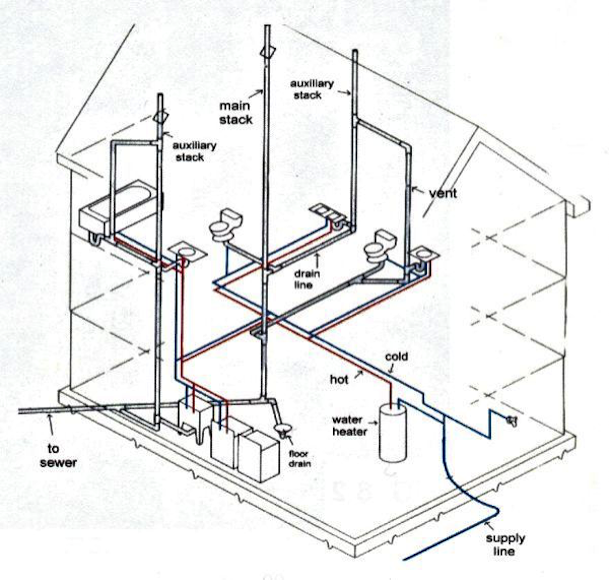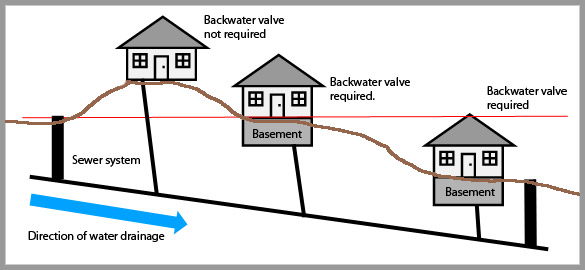An In-Depth Look at Your House's Plumbing System Anatomy
An In-Depth Look at Your House's Plumbing System Anatomy
Blog Article
How do you really feel when it comes to Understanding Your Home's Plumbing Anatomy?

Recognizing how your home's pipes system functions is vital for every home owner. From supplying clean water for drinking, food preparation, and showering to safely removing wastewater, a properly maintained pipes system is essential for your family's wellness and convenience. In this extensive overview, we'll check out the elaborate network that makes up your home's pipes and offer tips on upkeep, upgrades, and taking care of typical issues.
Intro
Your home's pipes system is more than simply a network of pipes; it's an intricate system that guarantees you have access to tidy water and effective wastewater elimination. Understanding its components and exactly how they work together can aid you avoid pricey repair work and make certain whatever runs efficiently.
Fundamental Elements of a Pipes System
Pipelines and Tubing
At the heart of your pipes system are the pipes and tubes that bring water throughout your home. These can be constructed from various products such as copper, PVC, or PEX, each with its advantages in regards to resilience and cost-effectiveness.
Fixtures: Sinks, Toilets, Showers, and so on.
Fixtures like sinks, commodes, showers, and bathtubs are where water is made use of in your home. Recognizing how these components attach to the pipes system helps in detecting problems and intending upgrades.
Valves and Shut-off Points
Shutoffs control the circulation of water in your pipes system. Shut-off valves are critical throughout emergencies or when you require to make repairs, enabling you to separate parts of the system without disrupting water circulation to the whole house.
Water System
Key Water Line
The main water line connects your home to the community water system or an exclusive well. It's where water enters your home and is dispersed to various components.
Water Meter and Pressure Regulator
The water meter procedures your water use, while a pressure regulator makes certain that water flows at a safe pressure throughout your home's pipes system, protecting against damages to pipes and fixtures.
Cold Water vs. Warm water Lines
Recognizing the difference between cold water lines, which supply water directly from the primary, and warm water lines, which carry heated water from the water heater, assists in repairing and preparing for upgrades.
Drainage System
Drain Water Lines and Traps
Drain pipelines bring wastewater far from sinks, showers, and bathrooms to the drain or sewage-disposal tank. Traps avoid sewer gases from entering your home and likewise catch particles that could create obstructions.
Ventilation Pipes
Air flow pipes allow air right into the drainage system, stopping suction that could slow water drainage and trigger traps to vacant. Appropriate air flow is necessary for keeping the honesty of your pipes system.
Relevance of Correct Water Drainage
Making certain correct water drainage prevents back-ups and water damages. Regularly cleansing drains pipes and preserving catches can stop expensive repair services and prolong the life of your plumbing system.
Water Heating Unit
Types of Hot Water Heater
Hot water heater can be tankless or typical tank-style. Tankless heating units warm water on demand, while tanks store warmed water for immediate use.
Upgrading Your Plumbing System
Reasons for Updating
Upgrading to water-efficient fixtures or changing old pipelines can enhance water quality, reduce water bills, and raise the worth of your home.
Modern Pipes Technologies and Their Benefits
Explore technologies like smart leakage detectors, water-saving bathrooms, and energy-efficient water heaters that can conserve cash and minimize environmental influence.
Expense Considerations and ROI
Calculate the ahead of time expenses versus long-term financial savings when taking into consideration plumbing upgrades. Many upgrades spend for themselves through reduced energy expenses and fewer fixings.
Just How Water Heaters Link to the Plumbing System
Comprehending just how hot water heater attach to both the cold water supply and warm water distribution lines helps in diagnosing issues like not enough warm water or leaks.
Maintenance Tips for Water Heaters
On a regular basis flushing your hot water heater to remove debris, checking the temperature level setups, and inspecting for leakages can expand its lifespan and improve power effectiveness.
Common Plumbing Concerns
Leaks and Their Reasons
Leakages can occur as a result of aging pipes, loosened installations, or high water pressure. Resolving leakages quickly prevents water damages and mold and mildew growth.
Obstructions and Obstructions
Clogs in drains pipes and commodes are usually triggered by flushing non-flushable things or an accumulation of oil and hair. Utilizing drainpipe displays and being mindful of what drops your drains can protect against blockages.
Signs of Pipes Problems to Expect
Low water stress, slow drains, foul odors, or abnormally high water costs are signs of prospective pipes troubles that need to be addressed immediately.
Plumbing Upkeep Tips
Regular Assessments and Checks
Set up annual plumbing examinations to capture issues early. Search for indicators of leaks, rust, or mineral build-up in taps and showerheads.
DIY Maintenance Tasks
Straightforward tasks like cleaning tap aerators, looking for toilet leaks utilizing color tablet computers, or insulating subjected pipelines in cool climates can avoid significant pipes issues.
When to Call an Expert Plumbing Technician
Know when a pipes issue requires expert know-how. Trying intricate repairs without proper understanding can cause even more damages and greater repair costs.
Tips for Decreasing Water Usage
Easy routines like taking care of leakages without delay, taking much shorter showers, and running complete loads of laundry and dishes can conserve water and lower your utility expenses.
Eco-Friendly Plumbing Options
Think about sustainable plumbing products like bamboo for floor covering, which is durable and green, or recycled glass for kitchen counters.
Emergency situation Readiness
Actions to Take Throughout a Pipes Emergency situation
Know where your shut-off shutoffs are located and exactly how to shut off the water system in case of a burst pipe or major leak.
Importance of Having Emergency Contacts Helpful
Keep contact details for regional plumbers or emergency services readily available for fast feedback throughout a pipes dilemma.
Environmental Impact and Conservation
Water-Saving Components and Devices
Mounting low-flow faucets, showerheads, and bathrooms can considerably reduce water usage without giving up efficiency.
DIY Emergency Fixes (When Applicable).
Short-lived repairs like utilizing duct tape to spot a dripping pipe or placing a pail under a trickling faucet can minimize damage till an expert plumbing gets here.
Verdict.
Comprehending the anatomy of your home's pipes system encourages you to preserve it properly, conserving money and time on repair work. By following normal upkeep regimens and staying informed concerning modern-day pipes innovations, you can guarantee your plumbing system operates successfully for several years to find.
HOW YOUR PLUMBING SYSTEM WORKS
Which Pipes Do What?
Blue lines = fresh water supply entering the building Red lines = hot water supply entering the building Grey lines = pipes carrying waste away from the building and venting pipes carrying gases away from the building (through the roof) YOUR MAIN PLUMBING SYSTEMS
There are two main plumbing systems that support your home s basic plumbing needs one that brings clean water into your home, and one that sends dirty water away from your home. Connected to the toilet, bath, shower, and other faucets in your home, these two systems keep your water flowing in the right directions.
ACCESSING FRESH WATER
Fresh and clean water is brought into your home through the main water supply line . Filtered through one pipe, this water is pressured to flow into the various fixtures in your home at any given time.
This water can be sourced from a well located on your property, a pond or river (mostly cottages), or, as in most cases, from the city s municipal water treatment centre. However, it is important to note that water that is untreated, such as the water siphoned from ponds or rivers, may not be safe to drink. Personal water supplies always need to be treated for hardness and contaminants before consumed.
MUNICIPAL WATER SUPPLIES
Improve taste and odour Remove sediment Eliminate hardness Reduce chlorine COLD WATER SUPPLY VS. HOT WATER SUPPLY
Cold water flows into your home or building through the service line, which then distributes hot or cold water to your fixtures. This line is most commonly run through a central column that runs floor to floor. Hot water runs in short and straight pipes as the longer the pipeline, the more heat that will be lost in the transfer. Having shorter pipes also allows residents to access hot water more quickly.
WASTE WATER SYSTEM
Your wastewater system is divided into two parts pipes that send wastewater away from your home and venting pipes that send sewer gas away from your home. Sewage water travels through pipes that flush the water and waste towards local sewers that are operated and managed by your city or town. Most sewer systems rely on gravity to move the wastewater to where it needs to go.
The further away from your toilet or sink, the larger wastewater pipes become. This allows for waste to be disposed of from various parts of your home or business at once without pipe blockages. The angle and flow of these pipes are also essential for keeping your waste pipes clear of build up.
https://harrisplumbing.ca/how-your-home-plumbing-system-works/

As a keen person who reads on Understanding Your Home's Plumbing Anatomy, I figured sharing that piece of content was really useful. So long as you appreciated our blog entry kindly do not forget to share it. We truly appreciate reading our article about Anatomy of a House: Understanding the Components.
Schedule A Free Estimate Report this page